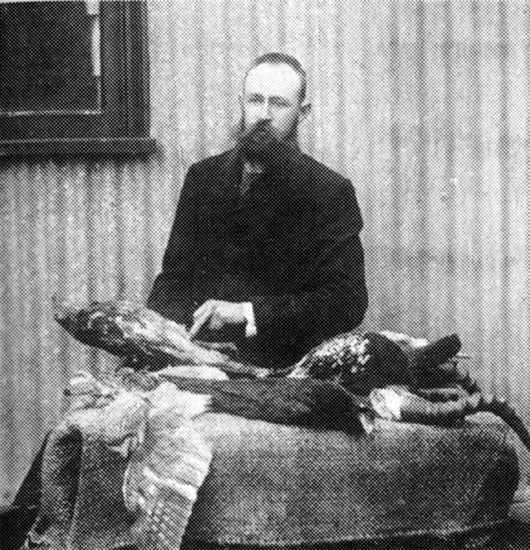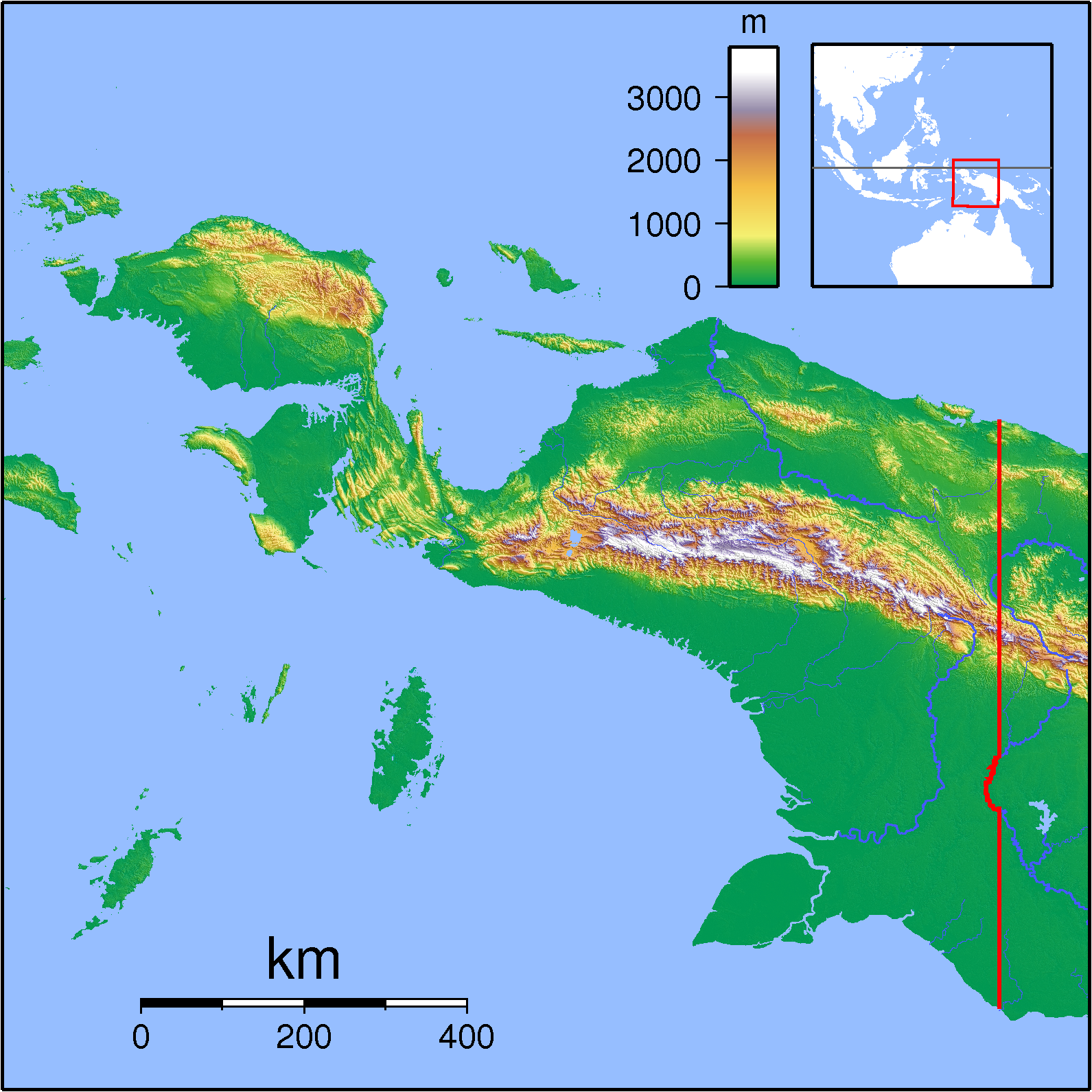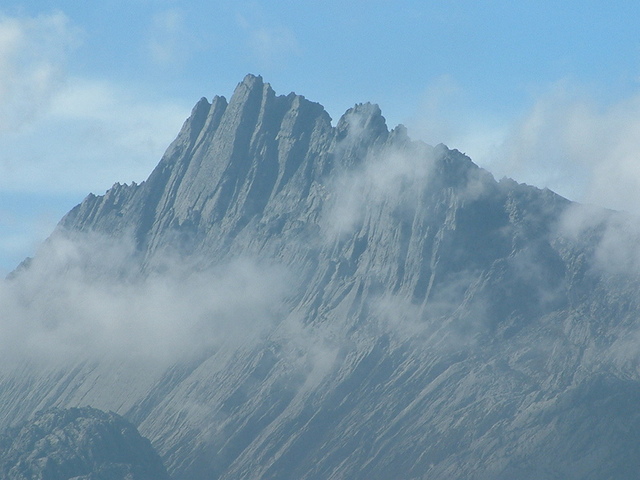|
Papuan Whipbird
The Papuan whipbird (''Androphobus viridis'') is a little-known and unobtrusive species of bird in the family Psophodidae. It is monotypic within the genus ''Androphobus''. It is found in Western New Guinea. It is currently classified as Least concern. This is probably due to the fact that it is very secretive, and, despite not being too restricted, thinly spread throughout its range; it is likely to be overlooked unless singing. It is apparently insectivorous. Description This species is 16–17 cm (6.3–6.7 in), making it significantly smaller than Australian whipbirds. Males have a moustachial white stripe and black throat while females are all moss green. Juveniles are darker green with blackish faces and underparts. Habitat It lives in montane forest, from 1,400 to 2,700 meters, where it inhabits the thick understory. It appears unlikely to be affected by habitat destruction, as steep slopes and inaccessible terrain make the area a difficult target for logging acti ... [...More Info...] [...Related Items...] OR: [Wikipedia] [Google] [Baidu] |
Ernst Hartert
Ernst Johann Otto Hartert (29 October 1859 – 11 November 1933) was a widely published German ornithologist. Life and career Hartert was born in Hamburg, Germany on 29 October 1859. In July 1891, he married the illustrator Claudia Bernadine Elisabeth Hartert in Frankfurt am Main, Germany, with whom he had a son named Joachim Karl (Charles) Hartert, (1893–1916), who was killed as an English soldier on the Somme. Together with his wife, he was the first to describe the blue-tailed Buffon hummingbird subspecies (''Chalybura buffonii intermedia'' Hartert, E & Hartert, C, 1894). The article ''On a collection of Humming Birds from Ecuador and Mexico'' appears to be their only joint publication. Hartert was employed by Walter Rothschild, 2nd Baron Rothschild as ornithological curator of Rothshild's private Natural History Museum at Tring, in England from 1892 to 1929. Hartert published the quarterly museum periodical ''Novitates Zoologicae'' (1894–39) with Rothschild, and t ... [...More Info...] [...Related Items...] OR: [Wikipedia] [Google] [Baidu] |
Understory
In forestry and ecology, understory (American English), or understorey (Commonwealth English The use of the English language in current and former member countries of the Commonwealth of Nations was largely inherited from British colonisation, with some exceptions. English serves as the medium of inter-Commonwealth relations. Many ...), also known as underbrush or undergrowth, includes plant life growing beneath the forest canopy without penetrating it to any great extent, but above the forest floor. Only a small percentage of light penetrates the canopy so understory vegetation is generally shade-tolerant. The understory typically consists of trees stunted through lack of light, other small trees with low light requirements, saplings, shrubs, vines and undergrowth. Small trees such as holly and dogwood are understory specialists. In Temperate broadleaf and mixed forest, temperate deciduous forests, many understory plants start into growth earlier in the year ... [...More Info...] [...Related Items...] OR: [Wikipedia] [Google] [Baidu] |
Birds Described In 1934
Birds are a group of warm-blooded vertebrates constituting the class Aves (), characterised by feathers, toothless beaked jaws, the laying of hard-shelled eggs, a high metabolic rate, a four-chambered heart, and a strong yet lightweight skeleton. Birds live worldwide and range in size from the bee hummingbird to the ostrich. There are about ten thousand living species, more than half of which are passerine, or "perching" birds. Birds have whose development varies according to species; the only known groups without wings are the extinct moa and elephant birds. Wings, which are modified forelimbs, gave birds the ability to fly, although further evolution has led to the loss of flight in some birds, including ratites, penguins, and diverse endemic island species. The digestive and respiratory systems of birds are also uniquely adapted for flight. Some bird species of aquatic environments, particularly seabirds and some waterbirds, have further evolved for swimming. Bi ... [...More Info...] [...Related Items...] OR: [Wikipedia] [Google] [Baidu] |
Birds Of Western New Guinea
Birds are a group of warm-blooded vertebrates constituting the class Aves (), characterised by feathers, toothless beaked jaws, the laying of hard-shelled eggs, a high metabolic rate, a four-chambered heart, and a strong yet lightweight skeleton. Birds live worldwide and range in size from the bee hummingbird to the ostrich. There are about ten thousand living species, more than half of which are passerine, or "perching" birds. Birds have whose development varies according to species; the only known groups without wings are the extinct moa and elephant birds. Wings, which are modified forelimbs, gave birds the ability to fly, although further evolution has led to the loss of flight in some birds, including ratites, penguins, and diverse endemic island species. The digestive and respiratory systems of birds are also uniquely adapted for flight. Some bird species of aquatic environments, particularly seabirds and some waterbirds, have further evolved for swimming. Bi ... [...More Info...] [...Related Items...] OR: [Wikipedia] [Google] [Baidu] |
Handbook Of The Birds Of The World
The ''Handbook of the Birds of the World'' (HBW) is a multi-volume series produced by the Spanish publishing house Lynx Edicions in partnership with BirdLife International. It is the first handbook to cover every known living species of bird. The series was edited by Josep del Hoyo, Andrew Elliott, Jordi Sargatal and David A. Christie. All 16 volumes have been published. For the first time an animal class will have all the species illustrated and treated in detail in a single work. This has not been done before for any other group in the animal kingdom. Material in each volume is grouped first by family, with an introductory article on each family; this is followed by individual species accounts (taxonomy, subspecies and distribution, descriptive notes, habitat, food and feeding, breeding, movements, status and conservation, bibliography). In addition, all volumes except the first and second contain an essay on a particular ornithological theme. More than 200 renowned specia ... [...More Info...] [...Related Items...] OR: [Wikipedia] [Google] [Baidu] |
Integrated Taxonomic Information System
The Integrated Taxonomic Information System (ITIS) is an American partnership of federal agencies designed to provide consistent and reliable information on the taxonomy of biological species. ITIS was originally formed in 1996 as an interagency group within the US federal government, involving several US federal agencies, and has now become an international body, with Canadian and Mexican government agencies participating. The database draws from a large community of taxonomic experts. Primary content staff are housed at the Smithsonian National Museum of Natural History and IT services are provided by a US Geological Survey facility in Denver. The primary focus of ITIS is North American species, but many biological groups exist worldwide and ITIS collaborates with other agencies to increase its global coverage. Reference database ITIS provides an automated reference database of scientific and common names for species. As of May 2016, it contains over 839,000 scientific nam ... [...More Info...] [...Related Items...] OR: [Wikipedia] [Google] [Baidu] |
Maoke Mountains
The Maoke Mountains is a mountain range in the province of Central Papua and Highland Papua. It extends over 692 km and is composed of the Sudirman and Jayawijaya ranges. It is part of the larger New Guinea Highlands or Central Cordillera. Although ''Maoke'' means 'snow' in the local language, the glacier on Puncak Trikora Puncak Trikora, until 1963 Wilhelmina Peak, is a 4,730 or mountain in the Highland Papua province of Indonesia on New Guinea. It lies in the eastern part of the Sudirman (Nassau) Range of the Maoke Mountains. Behind Puncak Jaya (Carstensz Pyra ... in the Maoke Mountains disappeared completely some time between 1939 and 1962. References External links UGSG Satellite Image Atlas of Glaciers of the World Mountain ranges of Western New Guinea Geography of New Guinea {{HPapua-geo-stub ... [...More Info...] [...Related Items...] OR: [Wikipedia] [Google] [Baidu] |
Sudirman Range
The Sudirman Range, also known as the Snow Mountains,"Sudirman Mountains (Snow Mountains)". Papua Insects Foundation. Accessed 5 August 2021/ref> Dugunduguoo, or Nassau Range is a mountain range in Central Papua province, Indonesia. It is named after the first armed forces commander-in-chief and Indonesian national hero Sudirman. It comprises a western portion of the Maoke Mountains. The highest peak in Oceania and Australasia, Puncak Jaya (4,884 m), is located here, as well as the large Grasberg copper and gold mine, operated by the Freeport company based out of the United States. Other peaks of the Sudirman Range are: * Sumantri (4,870 m) * Ngga Pulu (4,863 m) * Carstensz East (4,820 m or 4,808 m) See also * Lorentz National Park Lorentz National Park is a national park located in Central Papua, Indonesia, in the southwest of western New Guinea. With an area of 25,056 km2 (9,674 mi2), it is the largest national park in Southeast Asia. In 1999 Lorentz was decla ... [...More Info...] [...Related Items...] OR: [Wikipedia] [Google] [Baidu] |
Ornithologist
Ornithology is a branch of zoology that concerns the "methodological study and consequent knowledge of birds with all that relates to them." Several aspects of ornithology differ from related disciplines, due partly to the high visibility and the aesthetic appeal of birds. It has also been an area with a large contribution made by amateurs in terms of time, resources, and financial support. Studies on birds have helped develop key concepts in biology including evolution, behaviour and ecology such as the definition of species, the process of speciation, instinct, learning, ecological niches, guilds, island biogeography, phylogeography, and conservation. While early ornithology was principally concerned with descriptions and distributions of species, ornithologists today seek answers to very specific questions, often using birds as models to test hypotheses or predictions based on theories. Most modern biological theories apply across life forms, and the number of scientists ... [...More Info...] [...Related Items...] OR: [Wikipedia] [Google] [Baidu] |
Logging
Logging is the process of cutting, processing, and moving trees to a location for transport. It may include skidding, on-site processing, and loading of trees or logs onto trucks or skeleton cars. Logging is the beginning of a supply chain that provides raw material for many products societies worldwide use for housing, construction, energy, and consumer paper products. Logging systems are also used to manage forests, reduce the risk of wildfires, and restore ecosystem functions, though their efficiency for these purposes has been challenged. In forestry, the term logging is sometimes used narrowly to describe the logistics of moving wood from the stump to somewhere outside the forest, usually a sawmill or a lumber yard. In common usage, however, the term may cover a range of forestry or silviculture activities. Illegal logging refers to the harvesting, transportation, purchase, or sale of timber in violation of laws. The harvesting procedure itself may be ... [...More Info...] [...Related Items...] OR: [Wikipedia] [Google] [Baidu] |
Habitat Destruction
Habitat destruction (also termed habitat loss and habitat reduction) is the process by which a natural habitat becomes incapable of supporting its native species. The organisms that previously inhabited the site are displaced or dead, thereby reducing biodiversity and species abundance. Habitat destruction is the leading cause of biodiversity loss. Fragmentation and loss of habitat have become one of the most important topics of research in ecology as they are major threats to the survival of endangered species. Activities such as harvesting natural resources, industrial production and urbanization are human contributions to habitat destruction. Pressure from agriculture is the principal human cause. Some others include mining, logging, trawling, and urban sprawl. Habitat destruction is currently considered the primary cause of species extinction worldwide. Environmental factors can contribute to habitat destruction more indirectly. Geological processes, climate change, ... [...More Info...] [...Related Items...] OR: [Wikipedia] [Google] [Baidu] |
Forest
A forest is an area of land dominated by trees. Hundreds of definitions of forest are used throughout the world, incorporating factors such as tree density, tree height, land use, legal standing, and ecological function. The United Nations' Food and Agriculture Organization (FAO) defines a forest as, "Land spanning more than 0.5 hectares with trees higher than 5 meters and a canopy cover of more than 10 percent, or trees able to reach these thresholds ''in situ''. It does not include land that is predominantly under agricultural or urban use." Using this definition, '' Global Forest Resources Assessment 2020'' (FRA 2020) found that forests covered , or approximately 31 percent of the world's land area in 2020. Forests are the predominant terrestrial ecosystem of Earth, and are found around the globe. More than half of the world's forests are found in only five countries (Brazil, Canada, China, Russia, and the United States). The largest share of forests (45 percent) are in ... [...More Info...] [...Related Items...] OR: [Wikipedia] [Google] [Baidu] |

.jpg)


.jpg)

